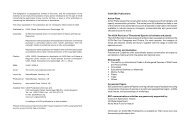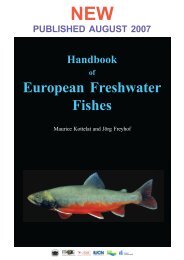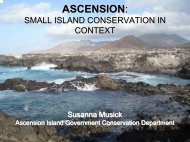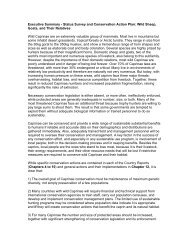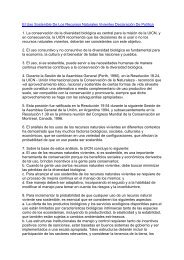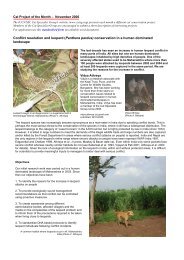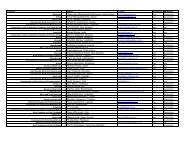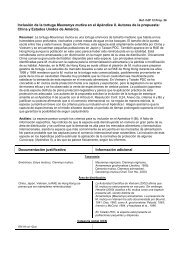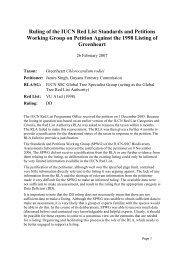Planning education to care for the earth - IUCN Knowledge Network
Planning education to care for the earth - IUCN Knowledge Network
Planning education to care for the earth - IUCN Knowledge Network
You also want an ePaper? Increase the reach of your titles
YUMPU automatically turns print PDFs into web optimized ePapers that Google loves.
Communication in support of protected areasPhase 1: Gazetting and administrative preparationIn this phase a national overview of <strong>the</strong> important conservation areas isdefined. Government agencies need <strong>to</strong> be notified of conservation interest in<strong>the</strong> area at <strong>the</strong> national regional and local levels. These include ministries ordepartments involved in <strong>for</strong>estry, <strong>to</strong>urism, agriculture, mining and energy,regional development, industry, public works, defence and so <strong>for</strong>th at <strong>the</strong>national level. In addition regional (<strong>the</strong>re are 27 regions) and local agenciesin planning, <strong>for</strong>estry, and population and environment need <strong>to</strong> be approached<strong>to</strong> approve <strong>the</strong> proposal and support its implementation. As a measure ofhow much has <strong>to</strong> be organized and kept track of in this agenda settingexercise, <strong>the</strong> principle agencies and <strong>the</strong>ir roles need <strong>to</strong> be listed. If <strong>the</strong>responsibilities of each agency are unders<strong>to</strong>od, <strong>the</strong> benefits of <strong>the</strong> protectedarea <strong>to</strong> that agency can be highlighted in presentations or communication <strong>to</strong><strong>the</strong>m. Non government organizations, representing various communityinterests are also involved in agreeing on <strong>the</strong> areas <strong>to</strong> be conserved and <strong>to</strong>determining acceptable boundaries. Once agreement is obtained and <strong>the</strong>boundaries defined, <strong>the</strong> proposed protected area is submitted <strong>for</strong> ministerialdecree.The role of communication in this process is <strong>to</strong> in<strong>for</strong>m and consult with allgovernment agencies, by both <strong>for</strong>mal and in<strong>for</strong>mal means. At <strong>the</strong> local level,awareness raising amongst local politicians about <strong>the</strong> proposal <strong>for</strong> aprotected area can be used <strong>to</strong> build community support. O<strong>the</strong>r local ac<strong>to</strong>rsdirectly involved in <strong>the</strong> protected area process are provided with simpleexplanations about <strong>the</strong> gazetting mission.The <strong>education</strong>/ communication activities include personal visits, surveys oflocal knowledge, attitudes and practices, establishment of contact withNGOs and community-based organizations (CBOs), <strong>the</strong> distribution of basicin<strong>for</strong>mation on <strong>the</strong> environment and protected areas, and regular briefings,interviews and meetings with interest groups.Phase 2 : Developing a management planOnce an area has been declared protected, a detailed management plan has <strong>to</strong>be finalized, in which threats <strong>to</strong> <strong>the</strong> area and <strong>the</strong> aims of conservation aredescribed. The park management, equipped with a detailed analysis ofthreats and opportunities and a clear picture of groups with a direct orindirect interest is ready <strong>to</strong> <strong>for</strong>mulate objectives. Instruments <strong>to</strong> support <strong>the</strong>conservation of <strong>the</strong> area such as <strong>the</strong> provision of subsidies, incomegeneratingsub-programmes, zoning systems and licensing based onenvironmental impact assessments are developed. The most effective mix ofpolicy instruments has <strong>the</strong>n <strong>to</strong> be established and local legislation may berequired. Community leaders and CBOs have <strong>to</strong> be involved in <strong>the</strong> design ofa zoning plan. Education/ communication advisors are essential in all <strong>the</strong>separticipa<strong>to</strong>ry activities.During this phase surveys of <strong>the</strong> knowledge, practices and attitudes of <strong>the</strong>local population and users of <strong>the</strong> area provide a basis <strong>for</strong> understanding how89



